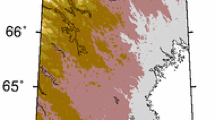Abstract.
Three different methods of handling topography in geoid determination were investigated. The first two methods employ the residual terrain model (RTM) remove–restore technique, yielding the quasigeoid, whereas the third method uses the classical Helmert condensation method, yielding the geoid. All three methods were used with the geopotential model Earth Gravity Model (1996) (EGM96) as a reference, and the results were compared to precise global positioning system (GPS) levelling networks in Scandinavia. An investigation of the Helmert method, focusing on the different types of indirect effects and their effects on the geoid, was also carried out. The three different methods used produce almost identical results at the 5-cm level, when compared to the GPS levelling networks. However, small systematic differences existed.
Similar content being viewed by others
Author information
Authors and Affiliations
Additional information
Received: 18 March 1999 / Accepted: 21 March 2000
Rights and permissions
About this article
Cite this article
Omang, O., Forsberg, R. How to handle topography in practical geoid determination: three examples. Journal of Geodesy 74, 458–466 (2000). https://doi.org/10.1007/s001900000107
Issue Date:
DOI: https://doi.org/10.1007/s001900000107




